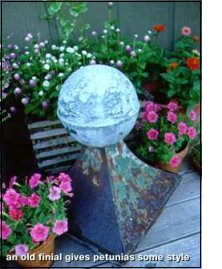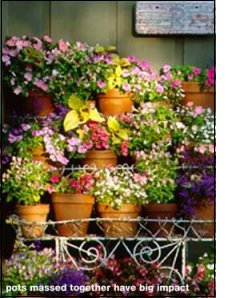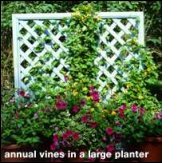
The Achla Bayit Store. Here you will be able to browse and buy the best of home and garden products from around the world. Including The Book Store -- books and magazines that will inspire your imagination.




|
|

| |
Another great article from garden.com 
  

Container gardening is the great equalizer. It doesn't matter what zone you live in, the amount of land you have, your annual rainfall, or the quality of your soil. Container gardening allows apartment dwellers to grow flowers and vegetables and cold-climate Northerners to experience the lushness of tropical plants. Space and climate have no dominion here. Container gardens are moveable feasts that place all gardeners on common ground.
 1. Choose your container
You can use any kind of vessel for container gardening: terra cotta, concrete, wood, or plastic. For fun, keep your eye out for unique containers such as buckets, wooden boxes, baskets�anything that can hold soil (for creative use of containers, read our feature "Found Objects--Beyond the Flower Pot" which will be online the week of May 11th). Here are some requirements for a good pot, regardless of what it's made of: Drainage holes. Drainage is as important to container plants as it is to those growing in your garden. If your pots don't have drainage holes, excess water can't drain away. Adequate depth. You can grow plants in tiny pots, but to reduce watering chores, you're better off with pots at least 6 inches deep. 1. Choose your container
You can use any kind of vessel for container gardening: terra cotta, concrete, wood, or plastic. For fun, keep your eye out for unique containers such as buckets, wooden boxes, baskets�anything that can hold soil (for creative use of containers, read our feature "Found Objects--Beyond the Flower Pot" which will be online the week of May 11th). Here are some requirements for a good pot, regardless of what it's made of: Drainage holes. Drainage is as important to container plants as it is to those growing in your garden. If your pots don't have drainage holes, excess water can't drain away. Adequate depth. You can grow plants in tiny pots, but to reduce watering chores, you're better off with pots at least 6 inches deep.
2. Use container-friendly potting soil
The soil in containers dries out faster than the soil in garden beds because it is more exposed to wind and sun. So, it's a good idea to use a potting soil mixture with a high percentage of sphagnum peat moss. This finely milled bog product soaks up water and holds it so that it doesn't drain away. Another advantage to using potting soil with sphagnum peat moss is that it's lighter than regular garden soil--that will mean a lot to your back when you move your container from your patio to your front porch. And a lighter mixture is really important for hanging baskets and window boxes.
Size is also an important consideration when choosing a container. You will have to take into account how much space you want to allocate for your garden. If you want to use only a small corner of your balcony for a small garden you might choose small perinnials (mums, carnations, miniature roses). You can use 3 or 4, 12-16 inch pots, which will provide plenty of room for the plant to grow in before you need to transplant it. With the ability to use 3 or 4 different containers you can then be more flexible and use more variations of plants.
3. Choose pot-loving plants
You can grow all types of plants in containers--annuals, perennials, roses, vines, shrubs, and even trees.
Sun-loving flowers: Annual flowers love the sun and make perfect container residents. For blue or purple flowers, try verbena or lobelia. Add the brightness of yellow and orange by planting marigolds, strawflowers, or lantana. For white flowers, try petunia, sweet alyssum, or dusty miller (which has gray foliage). And red or pink-flowering container plants include dianthus or celosia. Perennials do well in containers too, especially tropicals such as hibiscus and jasmine and bulbs such as calla lily and crocosmia.
 Shade-tolerant flowers: Impatiens and fibrous begonias add bright color to dark spots such as screen porches or shade gardens. Baskets filled with hosta and coleus are great garden accents and the hosta can overwinter in cold climates in a garage. Caladiums are quite elegant planted en masse in planters or window boxes--and should be located in protected areas so their elephant-ear leaves aren't buffeted by the wind.
Shade-tolerant flowers: Impatiens and fibrous begonias add bright color to dark spots such as screen porches or shade gardens. Baskets filled with hosta and coleus are great garden accents and the hosta can overwinter in cold climates in a garage. Caladiums are quite elegant planted en masse in planters or window boxes--and should be located in protected areas so their elephant-ear leaves aren't buffeted by the wind.
Roses: Lots of roses adapt well to containers. 'The Fairy' rose is one of our favorites because its arching branches with small pink blooms hang over the sides of the container. Miniature roses are also excellent container subjects. For height, color, and fragrance, try standard roses on your patio or deck.
Vines: Vines do quite well in containers, too. Insert a small trellis right into the pot, then plant annual vines such as morning glory or moonflower. You can also grow perennial vines such as ivy or clematis.
Shrubs and trees: Yews, arborvitae, oleander, holly and small juniper cultivars make instant impact in pots. Plus, their evergreen foliage provides color and interest year-round.
Vegetables: When you're planting your container garden, don't overlook vegetables and herbs. Many edibles thrive in containers and you can have fresh produce where ever and whenever you need it. In the spring, try growing a salad garden in a large tub; lettuces such as 'Buttercrunch' and 'Salad Bowl' do well in pots. Herbs such as rosemary, basil, thyme, and sage sometimes do better in pots than in your garden. In the fall, you can move the entire pot indoors for continued use.
 4. Water generously
The soil in containers dries out quicker than the soil in your garden so you need to water containers more often that you water your garden. Container plants generally are more exposed to drying winds and lose moisture through their leaves. Check the moisture level of the soil every day and water when the soil is dry to the touch. On hot summer days, you should plan to water once to twice a day. Keep in mind that some pots, such as terra cotta, act like a wick and draw moisture from the soil, so you'll have to water plants in these pots more frequently. A simple solution is a container drip irrigation system that allows you to water your container with the efficient drip method (that means less loss of water due to evaporation). 4. Water generously
The soil in containers dries out quicker than the soil in your garden so you need to water containers more often that you water your garden. Container plants generally are more exposed to drying winds and lose moisture through their leaves. Check the moisture level of the soil every day and water when the soil is dry to the touch. On hot summer days, you should plan to water once to twice a day. Keep in mind that some pots, such as terra cotta, act like a wick and draw moisture from the soil, so you'll have to water plants in these pots more frequently. A simple solution is a container drip irrigation system that allows you to water your container with the efficient drip method (that means less loss of water due to evaporation).
 tips to creating a great container garden tips to creating a great container garden
1. Size counts. Make sure that your plants are in scale with your containers--strive for balance. Otherwise you may end up with a top heavy planting that falls over easily in a small wind burst. For example, don't plant tall species such as blue salvia or cosmos in a small pot. The plants won't do well, and, if exposed to wind, may be upended.
2. Water in the morning. Whether you hand water or use a drip irrigation system, always water your container plantings in the morning. Evening waterings don't allow enough water evaporation and may cause fungus problems for some plantings, such as container roses.
3. Are they MOVEABLE feasts? Keep in mind that if you live in a climate that requires you to take your plants indoors, you may want to limit yourself to those that fit well in your home--or plan to treat container plantings as annuals that can be discarded. For example, if you have two 5-foot hibiscus on your patio and you live in Vermont, you'll have to bring them indoors before frost in the fall or treat them as annuals.
4. Color overhead. When you're planning your container garden, don't overlook the colorful possibilities you can create with flower-filled hanging baskets or window boxes. Just remember, when you plant containers like these, fill them with trailing plants such as ivy geranium, cascading petunia, bacopa, or asparagus fern.
Other related articles:
Color spots - flowers in pots
The kitchen garden - container gardening
<< Back to Gardening
|
|

|
|









